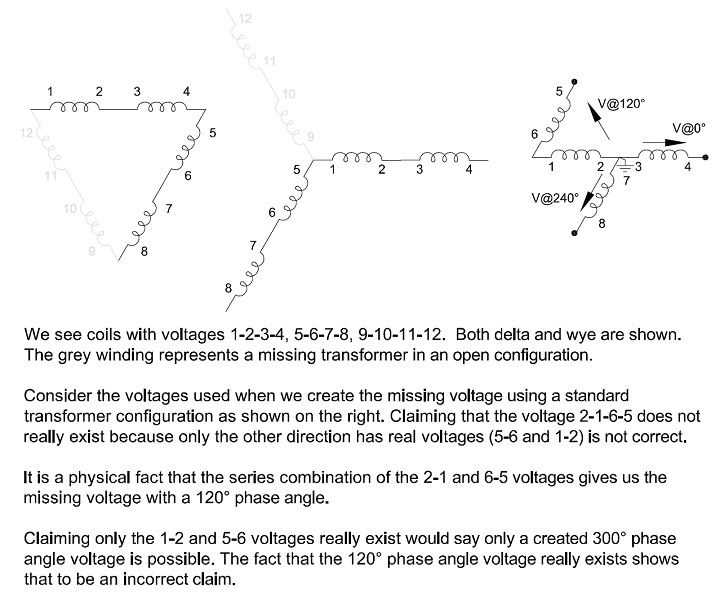Yes, but the disagreement is over the description of what causes this phase shift. It is equal or equivalent to a 180 deg phase shift. But it is not caused by a phase shift. It is caused by reversing the leads relative to the winding turn direction. The transformer itself is homogeneous, the connection causes the difference.
It is also the connection that causes a phase shift in a 3-phase to 2-phase transformer bank.
In this case you combine sources that do have a time shifted phase difference, caused by their origin at the generator and carried through the system.
The shifts are caused by manipulating the connections, not time.
Again the sources available for combination do have a phase shift that is carried through the system, two cores with two phase displaced fluxes.
Look again. The shift was caused by taking voltages in a winding direction opposite to the directions for the other phases.
Most likely the transformer has overlapping windings sharing a uniform single flux. I believe you are referring to possible differences in current flow in the secondary windings which would have a flux difference equivalence. The difference would be caused by the difference in the current flow between the windings and not by differences in the shared flux. The windings share the same flux but can have different loads and different current flows.
Then they can exhibit a difference and are not simply mirror images on either side of the neutral. It is not simply a matter of what goes on in one side of the winding being a simple inversion of what goes on in the other side. With some uses, it becomes evident that there are two phases present.
I have work scheduled for today and tonight. Plumbing and studying programming online when I take a break. This is such a great quote, I could spend a year replying to it. There are so many true and false paradigms it either is a source of concern and inquiry or it is not. It is no surprise stumbling into one.
Then take your time and try to understand what I was saying. Vab is not dependent on our summing Van and Vnb or subtracting Vbn from Van.
Likewise, in my wye example V5n is not dependent on us summing V56 and V12. By looking at the voltages present in the windings, we recognize that we can connect the transformer as shown to create V5n. We use the fact that the sum of V56 and V12 equals the V5n value of V@120? that we are missing.
With the connection as shown, we have many voltages available for the taking. For example, we have our classic set of 240/120 with the voltages V21 (V@0?) and V43 (V@0?). We also have the V12 (V@180?) and V34 (V@180?) voltages. We also have the V12 (V@180?) and V43 (V@0?) voltages.
Note that the V43 voltage (same phase angle as V21) is our V@0? voltage in the 3-phase set but also note that V12 voltage (V@180? and the reverse of V21) is used in the same 3-phase set as part of the V@120? voltage. And "as part of" I mean the winding of course and that we are using the winding in the opposite direction to that of the other winding half.
Once we have our transformer connections configured, V5n is available as a voltage. But just because V5n is equal to the sum of V56 and V12 does not mean that V65 and V21 are not also available voltages. All of these voltages physically exist with the transformer configured like it is.
So it is the physical manipulation that made V5n available, not a time shift. We normally refer to this as manipulating the voltages, summing the voltages, subtracting the voltages, etc. but hopefully you will understand what is meant. In reality, V12 and V21 and V56 and V65 are going to be there regardless of how we manipulate the connections. The transformer configuration made the previously unavailable V@120? voltage available as V5n.
The single-phase transformer has V@0? and V@180? and 2V@0? and 2V@180? voltages available with the windings in series. Our configuration can make the 2V voltage avilable or not but it will not change the fact that V@0? and V@180? are both physically there.
I could also walk through the Scott T connection and show you that it is the physical manipulation, not time manipulation, that gives us the phase-shifted voltages.
I could also show you the delta-wye connections that have a 30? phase shift or a 210? phase shift. The difference in the phase shifts is taking voltages in a different direction through the windings. So indeed, a different direction does give us a shift in phase. Not a time shift but a physical shift. That is the way transformer connections work.
I'll post my wye example again here so you don't have to look for it and the terminal number references I made:






